Cymbidium: description, care and reproduction
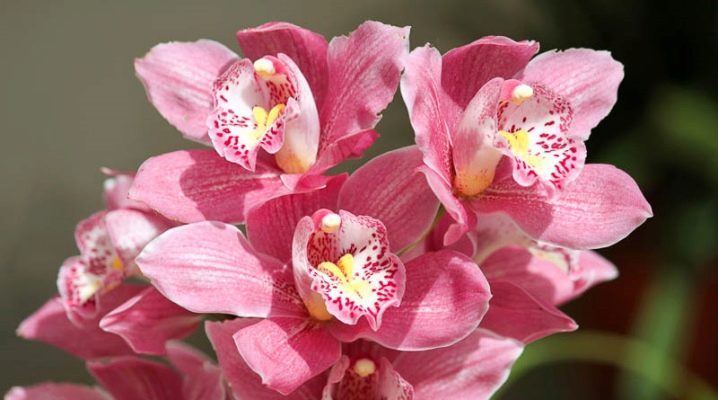
Cymbidium orchid (Latin Cymbidium) is well known to lovers of decorative indoor plants. The flower looks very festive and elegant, due to which it is often the main decoration of a home greenhouse.

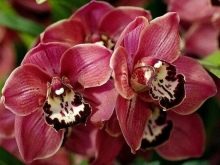
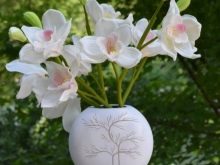
Peculiarities
Cymbidium is considered one of the most beautiful species of the Orchid family and has been known to mankind since ancient times. More than 2.5 thousand years ago, the great Confucius gave a high assessment to the decorative qualities of the plant, which is why it received the honorary title of "queen of fragrances". The flower is a genus of evergreen epiphytes, and is most common in the subtropical regions of Asia and northern Australia. Moreover, individual specimens of cymbidium can be found far in the mountains at an altitude of 2 thousand meters above sea level.
Today the flower is one of the most cultivated species in the Land of the Rising Sun and China, where professional growers obtain orchids of all kinds of colors and sizes. The most widespread are small species, which are considered more fragrant in comparison with large plants. However, the cultivation of cymbidium is not limited to the countries of the East.
The plant has become widespread in Europe, where breeders have bred more than 100 gorgeous hybrids.
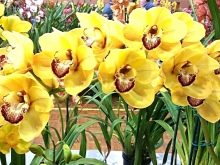
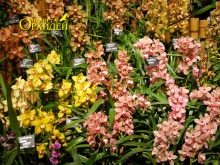
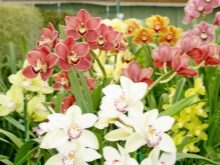
The first description of this truly royal flower was made by a Swedish biologist Peter Olof Swartz back in 1799. Since then, the morphological characteristics of the plant have undergone some changes as a result of hybrid crosses, but most of them have remained unchanged. So, in the wild, the cymbidium orchid is more often represented by the classic epiphyte, which is inhabited by the crowns and trunks of tropical trees. And despite the fact that there is an overwhelming majority of such plants, lithophytes are often found. They grow on stony soils and, in comparison with their counterparts, growing in more favorable conditions, have smaller forms.
A characteristic feature of all representatives of the species is the sympoidal type of development, in which shoot growth does not occur due to an increase in the trunk., and thanks to the appearance of new pseudobulbs, from which a peduncle grows over time. It is he who, having an erect or curved falling shape and strewn with many spectacular flowers, gives the plant a unique look. Flower petals can be of very different colors: yellow, pink, red and yellow-green, while their diameter often reaches 13 cm. In addition to the main petals, the flower has a so-called "lip", which stands out with a bright and very catchy heterogeneous color. Plants are highly pruning resistant and can bloom for several months.
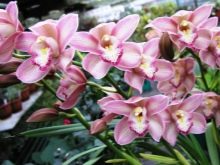
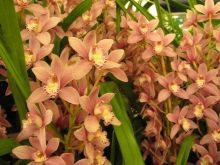

The growth of an adult cymbidium varies depending on the variety and is 20 cm in dwarf varieties and 1.5 m in large wild species. The plant has fleshy narrow leaves, pointed or rounded at the end of the form. When comfortable conditions are created, they remain green for three years, after which they die off and give way to young leaves. The stem of the cymbidium has a slight thickening - a pseudobulb, which is located near the ground and serves as a source of moisture supply necessary for the growth of the flower.
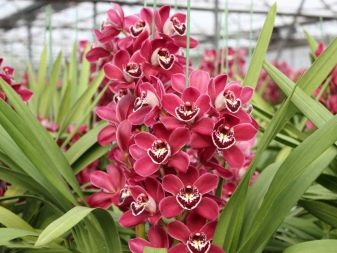
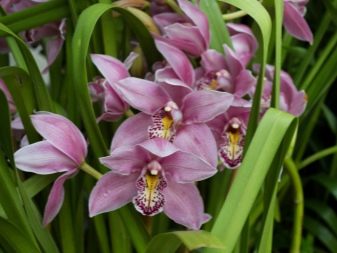
Popular types
Many growers consider cymbidium to be one of the most beautiful orchids, due to the excellent decorative properties of the flower and a wide variety of shapes and colors. Below are the varieties most popular in the opinion of florists, which are in high demand among indoor plant lovers.
- Cymbidium "Giant" was brought from India. It owes its name to long leaves, the size of which reaches 50 cm. In addition, the plant has a beautiful inflorescence of 10-15 flowers. The petals are greenish-yellow in color and decorated with purple-red stripes. Flowering lasts about six months. The flower is one of the most unpretentious and does not require specialized care.
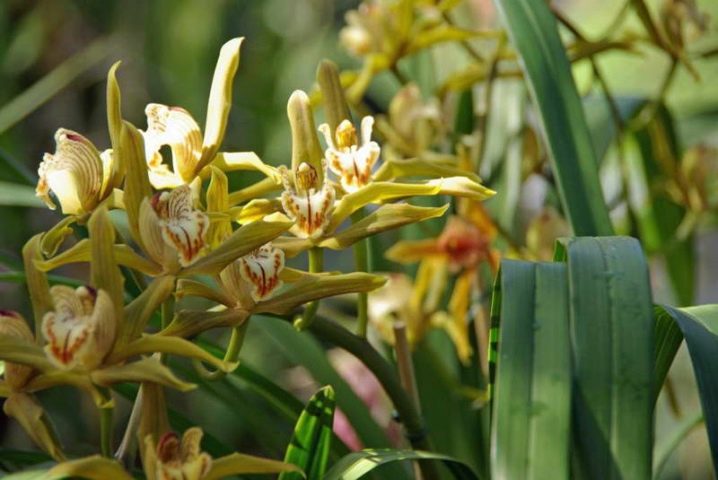
- Variety "Miniature" is a small orchid with hanging clusters of miniature flowers. The plant does not require the creation of greenhouse conditions and is capable of developing over a wide temperature range. Flowering begins in August and lasts up to 5 months.
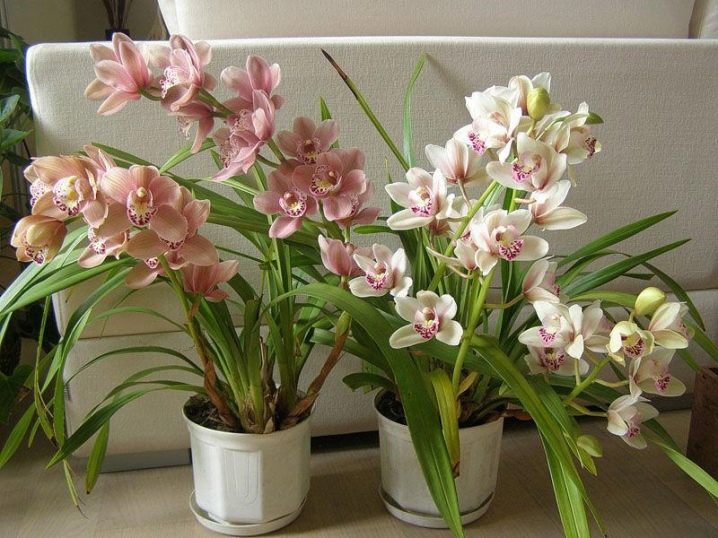
- Cymbidium "Low" It is considered the most widespread variety and is a lush beautiful bush with belt-like leaves up to 75 cm long. The peduncle contains 25 flowers up to 10 cm in diameter, belonging to the category of long-lived. They have olive yellow perianths and a showy lip with a broad red streak and a white center. It was this variety that was taken as one of the parent individuals for most of the hybrids.
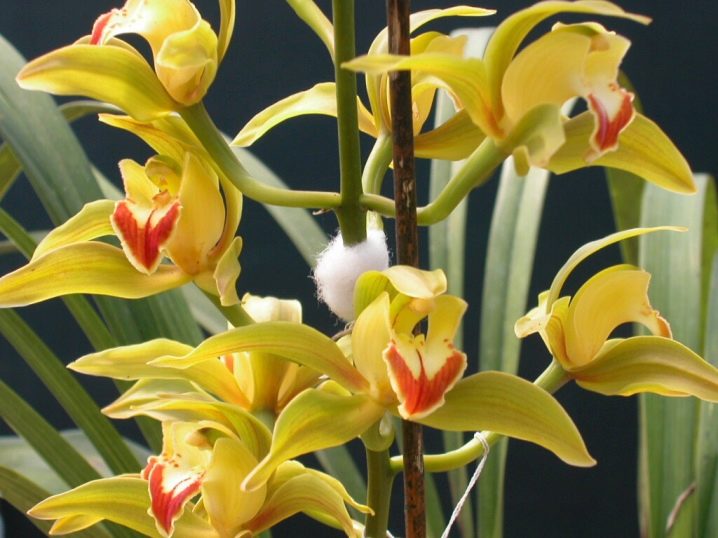
- Cymbidium "Vogels Magic" it is distinguished by an unusual spotted coloring with an interesting shade. The flowers of the plant are medium in size, beautifully shaped and have a spectacular lip. Abundant drooping inflorescences look very elegant, which is why they are often present in home collections.
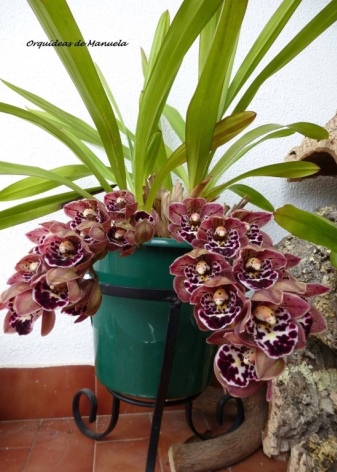
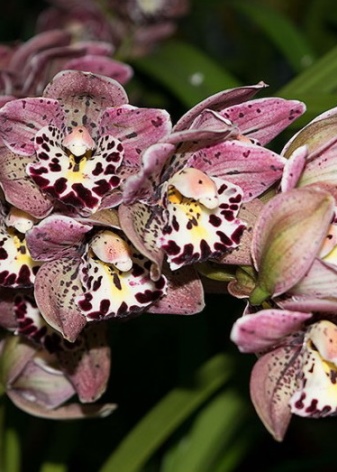
- Cymbidium "Ice Cascade" or, as it is also called, "butterfly orchid", is an epiphytic plant that grows in the wild forests of Australia and Southeast Asia. Blooming of flowers occurs gradually from the base of the brush and is delayed for several months. This creates the illusion of an ever-flowering plant and makes it one of the most popular varieties. The plant is absolutely unpretentious and grows equally well both in natural conditions and indoors.
A distinctive feature of the variety are very large brushes, sometimes containing 300 flowers.
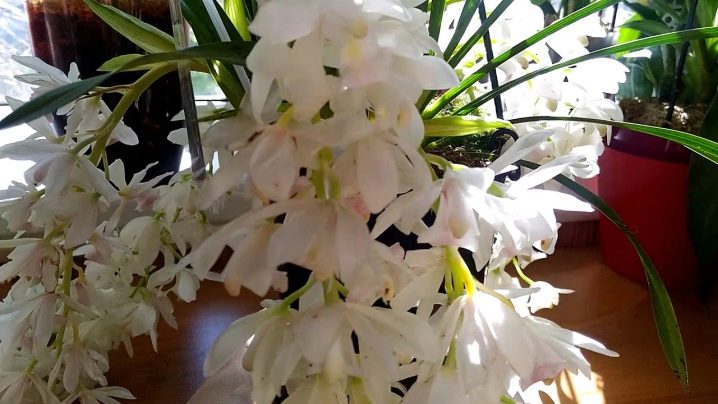
- Cymbidium "Mechelistny" is a popular orchid species. It is distinguished by sessile matte leaves up to 94 cm long and an upright inflorescence up to 67 cm long. The plant's roots are also very long and fleshy, pseudobulbs are underdeveloped and ovoid. The flowers reach 5 cm in diameter, smell very nice and do not fade for 2-3 weeks. Their petals are decorated with red-brown spots, and the "lip" can be white, yellow or green with red-brown veins.
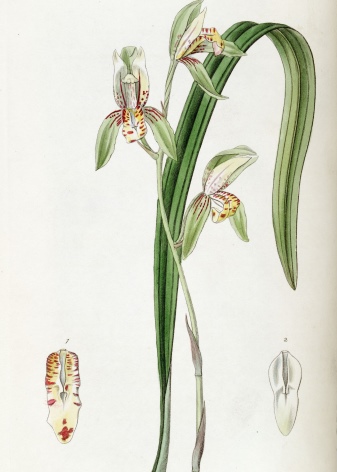
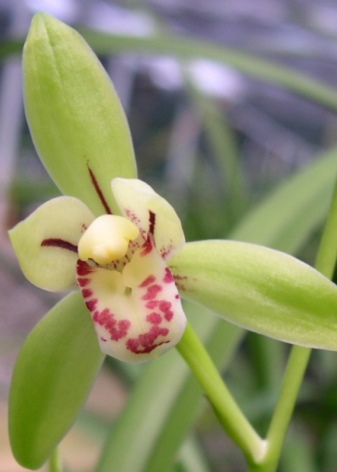
Flower selection rules
Before going to a flower shop for an orchid, it is advisable to familiarize yourself with some rules for its selection. This will help to acquire a strong plant that will delight the owners with its beauty for a long time. Therefore, one of the main tasks is the ability to distinguish a diseased plant from a healthy one. So, cymbidium can often be seen on the shelves of large retail chains, but buying a flower in such a place is a rather risky business.
This is due to the fact that flowers in supermarkets are not provided with proper care and are not under the supervision of a specialist. It is better to buy cymbidium at a specialized flower shop or floristry center. There, dust particles were probably blown off the plant and conscientiously looked after. In addition, the greenhouse staff will be able to provide comprehensive information on this variety and give practical advice on growing a flower.
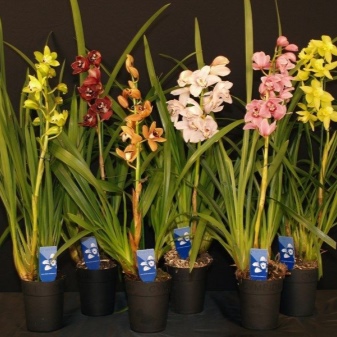

In general, the purchase of an orchid should be made only in the warm season, due to the tropical origin of the species and the risk of freezing it on the way home.It is also not recommended to buy an actively flowering plant, since the abundant growth of peduncles noticeably depletes and weakens it. This can make it difficult for the flower to take root in new conditions and impair its adaptation to new temperature and humidity.
The best option would be to buy a plant in which the arrows of the peduncles are barely beginning to bloom, and their number is not too large.
The next point to pay attention to when buying is the strength of the planting of the shoot in the pot. To do this, you need to take the plant by the base of the stem and gently move it from side to side. If the flower moves freely after the hand, then this means that it was recently transplanted and it did not have time to root properly. It is extremely undesirable to acquire such a plant, since it is impossible to check its viability in this case. If the orchid is sold in a transparent pot, then you need to pay attention to the root system.
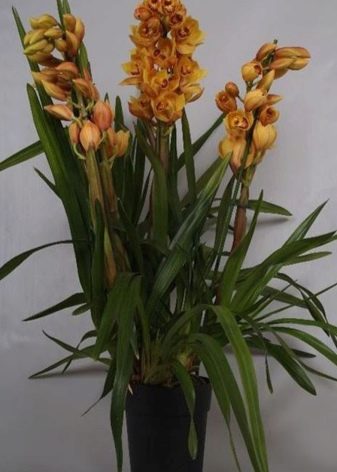

In a healthy plant, the roots will be elastic, without the slightest signs of wrinkling and drying out. It is also recommended to look at the color of the roots: in the shoots that are in a dry substrate, they should be white or light green, while in a moist soil, their color changes to dark green. If the root system is colored gray or brown, then the plant is obviously painful and in no case needs to be bought.
Sometimes it happens that the roots grow strongly and begin to hang from the pot. This is normal and should not be of concern to the purchaser. The main thing is that they are healthy and have the right color. Another important point is the visual inspection of the sheet plates. In a perfectly healthy plant, they should be approximately the same shape and not have visible damage. Growth points should also be examined: they should also not be damaged or wrinkled.
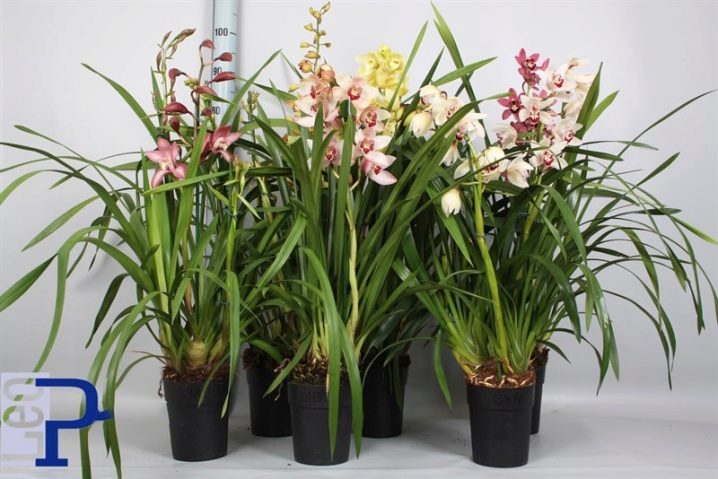
Home care
Indoor cymbidium orchids are hybrids of natural species and, like their progenitors, do not require special conditions. However, in order for the plant to grow well and develop correctly, it is still necessary to take care of it minimally. Flower care includes a number of activities.


Watering
Cymbidium requires abundant watering only during the growth of new pseudobulbs. Then the moisture is significantly reduced, and at the end of flowering, it is completely stopped. During rest, water the flower only after the substrate has completely dried. The resumption of watering begins after the flower has rested and new shoots will grow 2-3 cm. The best way to water orchids is to place the pot in a large container with water.
At the same time, the soil must be covered with a dense mesh, which prevents the earth from floating away from the gosh. The dipping should be short-lived, after which the flower should be shaken slightly and put into place.
However, there are varieties that are prohibited from watering during the development of the peduncle. This is due to the fact that even the slightest ingress of water can provoke rotting and death of the peduncle.
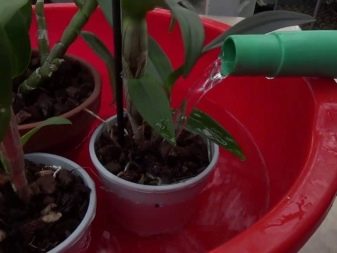
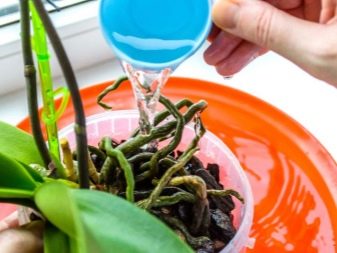
Lighting
Cymbidium orchids, due to their tropical origin, require a lot of light, but they do not tolerate too high temperatures very well. The best option for placing flower pots will be windows facing south and southwest. However, with prolonged flowering, which can last up to 9 months, it is recommended to use artificial lighting in winter. This is especially true for plants growing in winter conditions with short daylight hours and a complete absence of the sun.
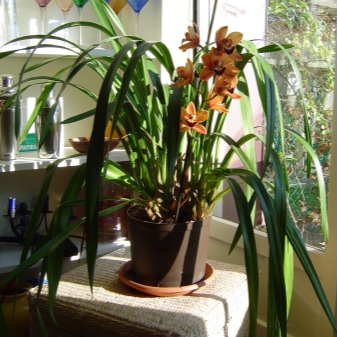
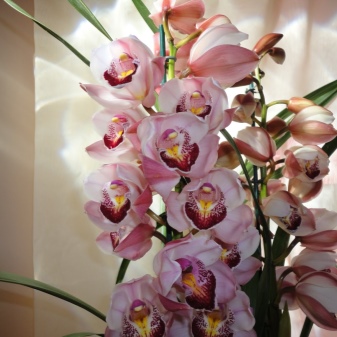
Temperature regime
Almost all cymbidium hybrids are perfectly adapted to home conditions and equally well tolerate summer room temperatures in excess of 35 degrees and winter temperatures barely reaching 18 degrees. However, during their growing season, it is recommended to create a daily temperature difference of 6-8 degrees.This is due to the genetic characteristic of plants that, growing in the wild, are regularly exposed to it, which is associated with the difference between day and night temperatures.
You should also know that if you stay in a hot room for a long time, the flower may die. Therefore, for comfortable growth, it is necessary to regulate the air temperature yourself. To do this, you can use a split system, which allows you to set the desired mode with an accuracy of one degree.


Creation of optimal humidity
Favorable humidity for cymbidium is considered to be 40-50%, however, during the growth of new pseudobulbs, it is recommended to increase it to 60%. But if in the room where the flower stands, the humidity indicators are much higher, then this is not critical, since the ancestors of the room orchid are tropical plants and are programmed for high humidity. If, on the contrary, the air in the room is too dry, then it is recommended to place the flower pot on wet pebbles or put a humidifier next to the plant.
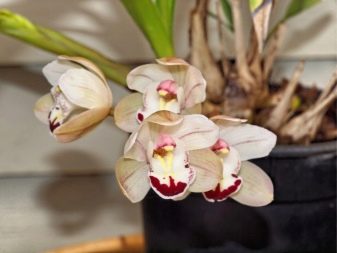

Fertilization
This event is the key to rapid growth and long-term flowering of the cymbidium and should be performed before flowering. It is better to buy special feed for orchids in the store, which are applied with every third watering. You can also use bulk mineral additives containing nitrogen and phosphorus. The first is recommended to be applied in the spring, and the second - at the beginning of autumn. Thus, the plants are fed twice a year, which is quite enough for them for full growth and abundant flowering.
During the dormant period, which lasts from early November to the onset of spring, the number of waterings is reduced and the plant is moistened only once every 2 weeks. It is desirable to create comfortable conditions for relaxation with an air temperature of 10-12 degrees and a humidity of 45%.
Thanks to this, the plant will calmly form new buds and in the next season will delight with abundant flowering.
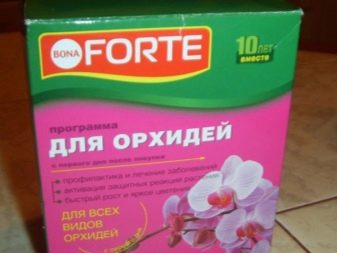
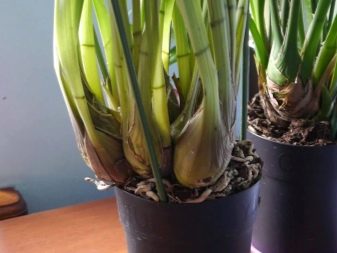
Transfer
The cymbidium should be transplanted no more than once every 2-3 years. The main reasons for transplanting a flower are caking of the substrate and the rapid growth of the bush, as a result of which the active formation of new pseudobulbs occurs, while the old ones only inhibit the development of the plant. The transplant can be started immediately after the last color has fallen off and continue until the new sprouts reach a length of 5-15 cm and begin to put down their own roots.
During planting, old pseudobulbs and dead roots must be removed, and wounded and damaged shoots must be treated with activated charcoal, brilliant green or ground cinnamon.
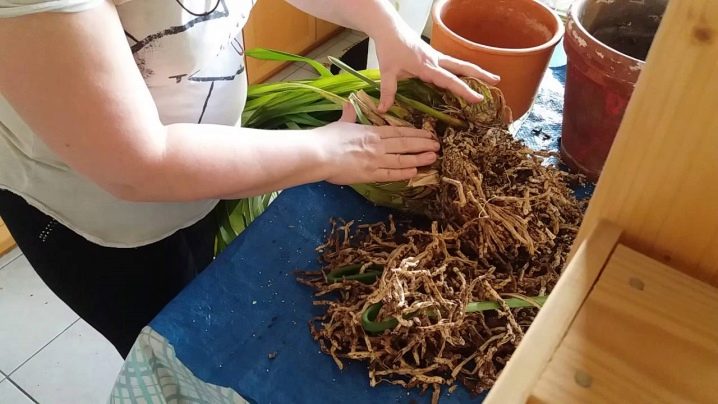
In order to transplant the cymbidium, the soil should be prepared. The best option would be to purchase a special substrate for orchids in the store, in which all the components useful for the flower are strictly balanced. If it is not possible to purchase a ready-made mixture, you can prepare it yourself. For this, finely chopped pine bark is mixed with dried fern roots and live moss. It is not recommended to use an earthen mixture as a substrate, as this leads to a violation of aeration, as a result of which the roots begin to rot quickly. When using a bark-based substrate, air freely penetrates to the roots, does not allow moisture to stagnate and leads to its rapid evaporation. In addition, the air, which is 75% nitrogen, saturates the roots of plants with it, which contributes to their rapid and correct growth.
After the new substrate is prepared, drainage is placed on the bottom of the wide pot and the mixture is poured. Then they carefully take the plant, straighten the roots and place it in the pot so that the new growth points are as close to the center of the pot as possible. After planting, the flower is placed in a quiet, shaded place and left for several days. Then the plant is watered and placed on the windowsill.


Reproduction methods
Reproduction of cymbidium is carried out exclusively by dividing the root or using old pseudobulbs. Other methods, including seed propagation at home, are not possible, therefore, despite the assurances of some sellers, it is not necessary to purchase orchid seeds. The seed method of reproduction takes place only in special laboratory conditions, which are practically impossible to reproduce in everyday life.
- So, in order to propagate a flower, you need to carefully separate three young pseudobulbs from the mother bush during its transplantation. In this case, it is desirable that two of them already have their own roots and at least one growth point is present. Next, young shoots are planted in separate pots with a new substrate and watered moderately for 1-2 months. After the growth of the flower becomes noticeable, it is transferred to the usual care regimen.

- The second breeding method is based on the use of pseudobulbs that bore fruit in the past season. To do this, old pseudobulbs, sometimes without leaves or roots, are separated from the main bush, placed in a plastic bag lined with wet moss, and sprayed. After the pseudobulbs have new root shoots, the plants are planted in a substrate and grown in the usual way.
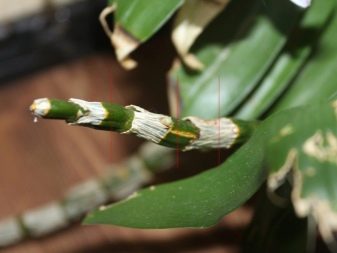
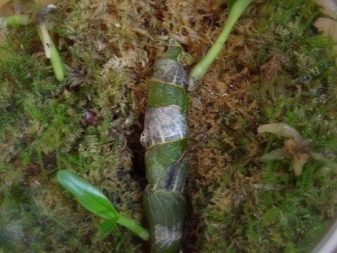
How to make an orchid bloom?
The flowering of cymbidium can last from 1-2 months to six months and depends on the variety, age and conditions created. The optimal temperature for flowering is 22 degrees with an air humidity of 50%. However, these parameters are fairly average and are not suitable for all varieties. For example, for plants with a height of 1.5 m and a flower diameter of 10-15 cm, a cool room with an air temperature not exceeding 20 degrees is necessary, while miniature species up to 60 cm high and a flower size up to 7.5 cm bloom beautifully in a warm room and do not require lowering the temperature.
If the plant does not bloom for some reason, you can try to stimulate this process yourself. For this, the flower is created as close as possible to natural conditions. So, if the homeland of the variety is mountainous regions with a difference in day and night temperatures of 4-5 degrees, then at home he needs to create exactly the same conditions. In this case, it is the temperature difference that acts as the main stimulus for the formation of buds.
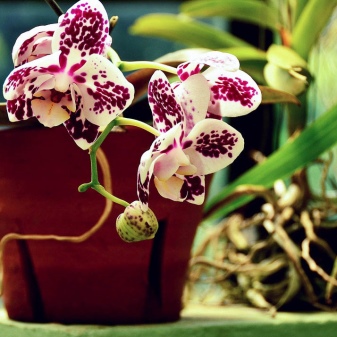
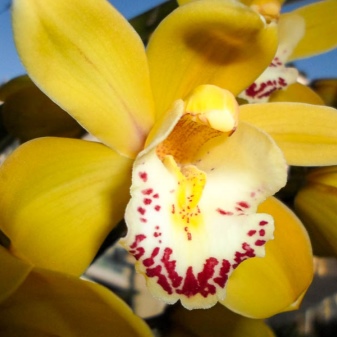
If the plant blooms in winter, then an insulated loggia will come to the rescue, in which you need to put pots at night. You should not worry at the same time: the cymbidium perfectly tolerates a decrease in night temperatures to 5-6 degrees and blooms well at the same time. Another important factor that stimulates orchid blooms is bright sunlight. To do this, the plant should be placed on the southern windows, while trying to prevent them from overheating significantly.
As soon as the cymbidium fades, it is immediately cut off and the necessary conditions for rest are created. If this is not done, the plant will gather strength and bloom again. As a result, the flower will weaken significantly and may die.

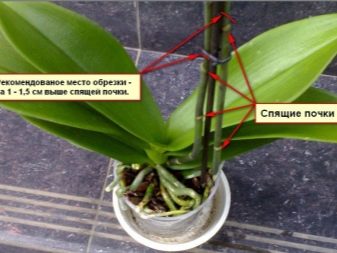
Diseases and pests
Cymbidiums are strong enough plants and rarely get sick. However, they can still undergo specific diseases inherent in all species of the Orchid family.
- One of these ailments is root decay, which occurs due to too much watering. The first sign of decay is the formation of black spots at the base of the leaf or the rapid yellowing of the plant. In such cases, resuscitation is powerless and the orchid eventually dies.
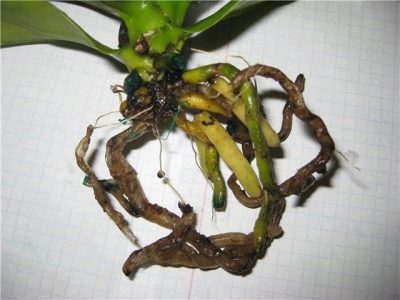
- If the tips of the leaves dry and turn black, then this indicates too low humidity in the room. Usually, these plants can be saved by removing damaged leaves and increasing the humidity in the air. Falling buds indicate a lack of elements such as calcium and phosphorus. The flower can be completely saved by feeding it with mineral fertilizers.
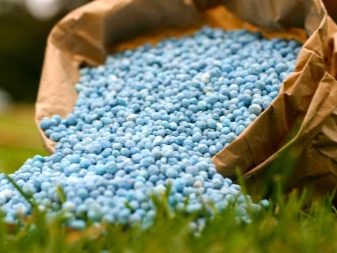

- If the roots of the cymbidium began to die off, and the leaves lost their former elasticity, then the matter is most likely in the prolonged exposure to high temperatures and poor ventilation of the room.
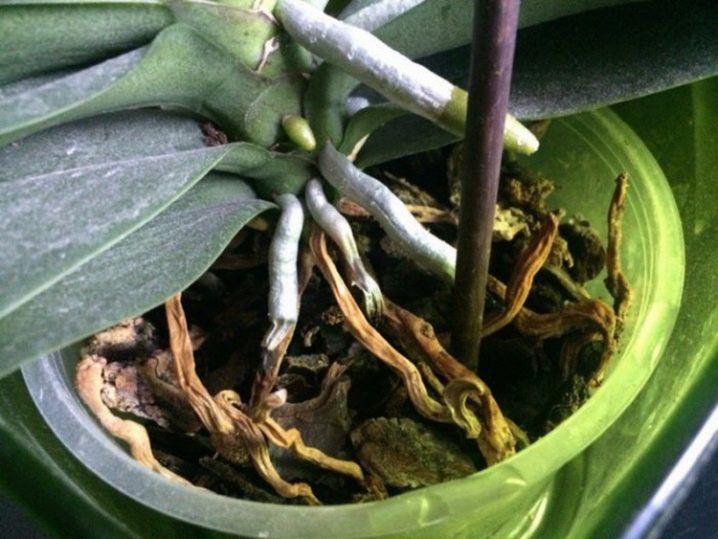
- Dry areas on leaf plates are nothing more than sunburn. When they appear, the flower should be protected from direct sunlight by placing it in the shade of more sun-loving species.
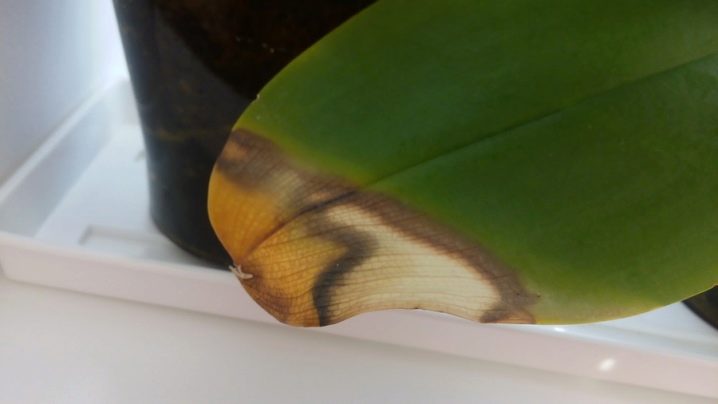
In addition to diseases caused by flaws in the care, orchids are sometimes exposed to viral ailments. One of them is a viral mosaic, which can be recognized by the presence of yellow spots and stripes, as well as a slowdown in growth and a change in the shape and color of flowers. Unfortunately, this disease cannot be cured and the plant must be destroyed. Another ailment is leaf edema, manifested in the formation of small growths surrounded by a watery membrane.
The cause of this disease is a decrease in temperature against a background of high humidity in the room. These conditions are also responsible for the appearance of gray and brown rot, which affects almost all parts of the plant. However, these diseases are not fatal and when diseased leaves are found, they are simply removed, not forgetting to take measures to improve the conditions for keeping the flower.
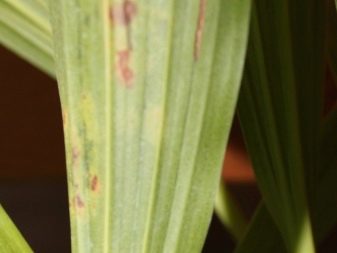

As for pests, orchids are occasionally affected by the thyroid gland and aphids. To destroy them, insecticidal preparations are used, and in the event of a spider mite, the leaves are wiped with natural beer.
For the secrets of flowering cymbidium, see the next video.































The comment was sent successfully.